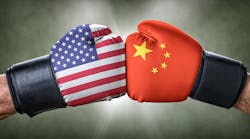The September 3 article, “ISM Report: US Manufacturing Contracts for the First Time in Three Years” may be a leading indicator that American manufacturers and consumers will start feeling negative impacts of this country’s tariffs on Chinese imports. The point of making this observation is not to question whether this trade war is necessary—in my mind, it is—but rather to point out the reality that if it goes on much further, there will likely need to be some belt-tightening in this country.
To date there hasn’t been much noticeable impact—at least as consumers are concerned—since retailers have maintained pricing on Chinese goods. But at some point going forward, either prices on imports from China will rise or the companies selling them will start to suffer noticeable negative financial impact. Again, the point here is not to criticize the U.S finally taking on China, trade-wise, but to paint a realistic picture on what to expect if tariffs continue much further.
In fact, U.S. producers and manufacturers are already starting to feel the pinch. China has stopped buying U.S. soybeans and the administration has pumped $28 billion into a farming-industry bailout. At the same time, the government has tried to paint a rosy picture by telling farmers they are better off financially than they were in 2016 and that the agricultural bailout is being paid on the tariffs the Chinese are paying. As we continue in the trade war, I believe it is important to be forthright, and it is a fact that the agricultural industry is hurting.
First, although tariffs may mean U.S. imports of Chinese goods have been reduced—hurting their economy significantly—China doesn’t pay for the tariffs. Instead, tariffs are paid for by the company importing them to our country. As stated above, the cost of these tariffs will eventually either be reflected in increased prices or reduced financial results for the importers.
Paul Ericksen's columns are part of IndustryWeek's Supply Chain Initiative.
Second, I have a hard time believing U.S. farmers are economically better off now than before the tariffs. Why? I’ll lay out an actual case that supports my position.
Some of you may know that I spent the first part of my career at John Deere. Because of that, I like keeping tabs on their financial status. Third-quarter results show that Deere profits are down 24% from a year ago.
The reason for this huge drop in revenue is because farmers are not buying as much new equipment as they normally do. By a lot. This has affected both company financial results and employment, with Deere announcing in August that another 145 production employees will be laid off in September.
The Deere example reflects the reality of the current U.S. farm economy. The longer the trade war goes on, the more we can expect to see similar impacts across other industries. Again, I’m not pointing this out to criticize the present tariffs. But I don’t think it is honest for our government to continue with the narrative that this trade war will be “easy.”
Let me draw an analogy related to this last point. When the United States engages in a shooting war there are casualties, and it is reasonable to expect the same result in a trade war. In a shooting war—when the war is for the right reason—the number of the wounded does not detract from the people of this country doing what they think is right. Instead, we honor the contribution of casualties, providing the wounded with Purple Hearts and all of the support we can.
Farmers and suppliers to the farming industry have become casualties of the current trade war. While medals may not mean much to companies and their laid-off employees, I do believe it is important to note that they are both taking the proverbial bullet for their country, and the country should give them whatever support it can.
Further Realism
Above, I pointed out that our current tariff strategy is hurting the Chinese economy. That economy is, in fact, under severe pressure. But there are still positive aspects of the Chinese economy.
Year-to-date, steelmakers worldwide have increased output an average of 4.6%. China’s output has outpaced this by a wide margin, increasing by 9% in 2019, compared to the comparable period in 2018. The U.S. has also increased its production, coming in just below the world average at 4.5%.
I think there is an important observation that can be made here. There is a worldwide market for the sale of commodities such as steel. This also applies to natural resources such as minerals, which are an important contributor to the Chinese economy. The result is that the tariffs we have imposed on China will negatively impact that country’s economy if their sales are highly dependent on U.S. purchases. This is not always the case, as the above data shows.
On the other hand, the U.S. is the primary buyer of Chinese manufactured products, so the tariffs are negatively affecting China’s fabrication manufacturers. The lesson here, I think, is that there needs to be a strategy in deciding where to impose tariffs, rather than applying them across the board. The administration has—to a point – recognized this in that they’ve incrementally phased-in tariffs based on the product type, so they deserve kudos on this. However, to be realistic about the trade war with China, it needs to be recognized that tariffs are not a silver bullet and other approaches may be needed.
Get Ready for the Big Five
I recently listened to the audiobook The Industries of the Future, by Alec Ross. Ross’ background includes serving as senior advisor for innovation for Secretary of State Hillary Clinton. In that role he traveled the world, seeing the industrial advances coming out of every continent. Based on these observations, the vision he presents for the future of industry is both timely and thought-provoking. While the book was published in 2016 and is already a bit dated, that in itself should give you an indication of how fast things are changing.
According to Ross, there are five industries that will spur economic growth: robotics, artificial intelligence, cybercrime and cybersecurity, the commercialization of genomes and big data. I won’t go into detail on why Ross believes this, but from his book it is pretty clear that countries that continue to rely on the industries currently supporting their economy will be economically outperformed by those that don’t. And Ross details several instances of various overseas governmental–industry relationships that have both launched and supported progress in these five areas to ensure ongoing competitiveness.
This brings up again the topic of what is the best approach to training and otherwise positioning American workers for the “jobs of the future.” The two options seem to be either exclusively relying on industry to take up the training challenge or the government strategically and financially partnering with business in this endeavor. In prior articles, I’ve opined that government-industry collaboration is the best route. Regardless, it needs to be understood that the decisions we make today about which approach to adopt will likely have long-term economic impacts on our country.
Paul Ericksen is IndustryWeek’s supply chain advisor. He has 38 years of experience in industry, primarily in supply management at two large original equipment manufacturers.





